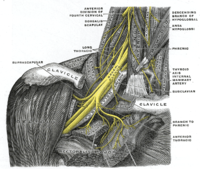
Photo from wikipedia
INTRODUCTION We sought to investigate the reliability of a new electrodiagnostic method for identifying Electrodiagnosis of Brachial Plexus & Vessel Compression Syndrome (BPVCS) in rats that involves the application of… Click to show full abstract
INTRODUCTION We sought to investigate the reliability of a new electrodiagnostic method for identifying Electrodiagnosis of Brachial Plexus & Vessel Compression Syndrome (BPVCS) in rats that involves the application of transcranial electrical stimulation motor evoked potentials (TES-MEPs) combined with peripheral nerve stimulation compound muscle action potentials (PNS-CMAPs). RESULTS The latencies of the TES-MEP and PNS-CMAP were initially elongated in the 8-week group. The amplitudes of TES-MEP and PNS-CMAP were initially attenuated in the 16-week group. The isolateral amplitude ratio of the TES-MEP to the PNS-CMAP was apparently decreased, and spontaneous activities emerged at 16 weeks postoperatively. MATERIALS AND METHODS Superior and inferior trunk models of BPVCS were created in 72 male Sprague Dawley (SD) rats that were divided into six experimental groups. The latencies, amplitudes and isolateral amplitude ratios of the TES-MEPs and PNS-CMAPs were recorded at different postoperative intervals. CONCLUSIONS Electrophysiological and histological examinations of the rats' compressed brachial plexus nerves were utilized to establish preliminary electrodiagnostic criteria for BPVCS.
Journal Title: Oncotarget
Year Published: 2017
Link to full text (if available)
Share on Social Media: Sign Up to like & get
recommendations!